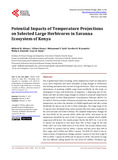| dc.description.abstract | Due to global land surface warming, severe temperature events are expected to occur more frequently and more extremely causing changes in biodiversity and altering movement and survival of large herbivores. There are increasing observations of escalating wildlife range losses worldwide. In this study, we investigated 15 large wild herbivores (4 migratory, 1 dispersing and 10 residents) and their potential range changes in relation to projected temperatures changes based on three Representative Concentration Pathways (RCPs) 2.6, 4.5 and 8.5. Previous studies of Kenyan savannah have shown that increases in temperature can reduce the densities of wildlife significantly and after certain thresholds the species can be lost in those landscapes. The range maps of the 15 species were developed from aerial censuses that have been conducted in the arid and semi-arid lands of Kenya. We analysed temperature changes for the three RCPs for the periods 2030s, 2050s and 2070s. And based on the temperature threshold for each of the 15 species we analysed which wildlife range areas will be lost. Our results project that for the RCP 2.6, 3 out of the 15 species are projected to lose more than 50% of their range by the year 2030s, and 5 out 15 by 2050s and 4 of 15 by 2070s. The second climate scenario of RCP 4.5 projects that by 2030s, 3 species will lose more than 50% of their range, and in 2050s and 2070s 5 species. The RCP 8.5 which is the extreme scenario of temperature changes projects 5 species to lose their range by 50% in 2030s, 7 species by 2050s and 10 species by 2070s. The extent of range loss was different among species but was severe for buffalo, Thomson’s gazelle, waterbuck, and wildebeest which are also water dependent species. However, the elephant, gerenuk, hartebeest, lesser kudu, and oryx are expected to retain most of their range in all the RCPs scenarios. These range contractions raise serious concerns about the future of wildlife in Kenyan savannah based on projected climate changes. And therefore, it is imperative the wildlife sector develops climate policies and plans that take into account the projected climate scenarios.
Representative Concentration Pathways 2.6, 4.5 and 8.5, Species Range, Climate Adaptation and Management | en_US |



